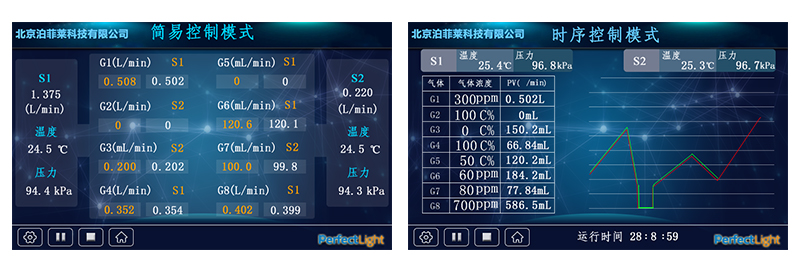Compared to static gas blending methods, dynamic gas blending not only provides high-flow mixed raw gases but also allows adjustment of the flow ratio between raw gases and dilution gases to achieve the desired concentration of standard gases. It is especially suitable for preparing low-concentration standard gases. In air and exhaust gas monitoring in environmental monitoring, standard gases serve as the basis for testing and evaluating methods, assessing sampling efficiency, plotting standard curves, calibrating analytical instruments, and conducting quality control in testing.
The PLD-DGCS 05 multi-component dynamic gas blending instrument uses mass flow mixing method to mix and dilute various raw gases with up to 8 channels. It can dynamically and in real-time prepare target gas mixtures with specific gas ratios.
The PLD-DGCS 05 multi-component dynamic gas blending instrument is equipped with dual gas outlets, which can be switched to different outlets through software operation. It can output target mixed gases separately or simultaneously from two channels. It also has the function of monitoring the temperature and pressure of the mixed gases. The output pressure of each outlet can reach 0.4 MPa.
Continuous flow, gas-solid phase, and gas-liquid phase reaction systems involving gas participation, such as photothermal catalytic CO₂ hydrogenation, photothermal catalytic CO hydrogenation, photothermal catalytic olefin or alkyne hydrogenation, photothermal catalytic methane dry reforming, photothermal catalytic reverse water gas shift reaction, photocatalytic degradation of gas pollutants, photocatalytic partial oxidation of methane, photocatalytic methane coupling reaction, photothermal catalytic Sabatier reaction, photocatalytic nitrogen fixation reaction, photocatalytic degradation of VOCs, etc.
The PLD-DGCS 05 multi-component dynamic gas blending instrument has two working modes: simple control and time control. It is equipped with a 7-inch touch screen, allowing different working modes to be selected directly on the touch screen.

The simple control mode of the PLD-DGCS 05 multi-component dynamic gas blending instrument adjusts the gas flow and gas distribution of a single channel to control the gas flow and mixing ratio at the outlet. It is suitable for dynamic gas blending requirements where gas flow and gas composition remain constant throughout the process. This operation is simple and is suitable for most gas-solid phase reaction experiments.
The time control mode of the PLD-DGCS 05 multi-component dynamic gas blending instrument can set different gas flow rates and gas distribution at different times, achieving the requirement of changing the flow rate and gas composition of the outlet over time. The gas flow rate can change linearly with time, and the gas composition can be quickly switched, enabling the gas composition at the outlet to be converted rapidly in a short period.

It can be used with PLR-GSPR atmospheric gas-solid phase photocatalytic reaction system, PLR MFPR-I multifunctional photochemical reaction instrument, and PLR-PTSRⅡ photothermal catalytic reaction instrument to obtain mixed gases with specific concentration, specific gas types, and specific humidity, meeting the needs of gas-solid phase photocatalytic reactions under complex gas conditions.

Attached is the common gas correction coefficient: "Gas Flow Rate, Are You Setting It Right?".
Attention
When using toxic and harmful gases, strict protective measures must be taken, and the airtightness of each interface must be checked rigorously. After gas blending, use inert gas to blow each channel again;
When the gas cylinder contains corrosive gas, the gas type and concentration must be specified in advance, and it must be connected to the corresponding inlet as specified;
There must be a pressure reducing valve in front of each gas inlet. When the instrument is not used for a long time, cut off the gas source;
All flow rates of the PLD-DGCS 05 multi-component dynamic gas blending instrument that are not specifically indicated refer to the flow rates under standard conditions. Standard conditions refer to: 0°C, 101.325 kPa.